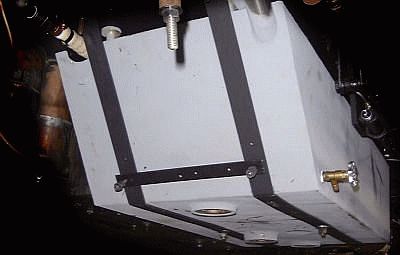
replacement galvanized water tank located under the floor boards. to make cleaning easier this tank has been outfitted with three drain plugs installed. a water valve has also been added to the side to provide a source of water for hand washing and hot parts cooling during those occasional road trip emergency repair sessions which may occur with even the best maintained stanleys.
Initially Stanley constructed 15-gallon to 25-gallon water tanks of copper and located them under the seats of their cars. By 1910 the tanks had grown in size to 45-gallons and were now located at the rear of the car being placed partially under the rear seat and partially extending from the rear of the car. Only the Stanley Mountain Wagons had larger tanks carrying 50 gallons of water.
With the introduction of condensing cars in 1915 a uniform tank capacity of 25 gallons was adopted along with a single 20-horsepower boiler/engine combination. Initially of copper but soon changed to galvanized steel the tanks were suspended with two steel straps attached to the steel frame beneath the floorboards of the car. This location allowed the top of the tank to be below the bottom of the condenser thus insuring condensate from the condenser would flow to the water tank by gravity.
A gauge assembly projecting through the floorboard just in front of the driver provides an indication of the water level in the tank. The water tank can be filled either of two ways. The simplest is to remove the condenser cap and us a hose fill the water tank through the condenser. An alternate way of filling the water tank is though the use of the siphon. At the center of the tank is a standpipe that acts as an overflow for the tank when filling. The standpipe also insures pressure will not build up in the tank from the exhaust steam of the engine being routed through the condenser and to the water tank.